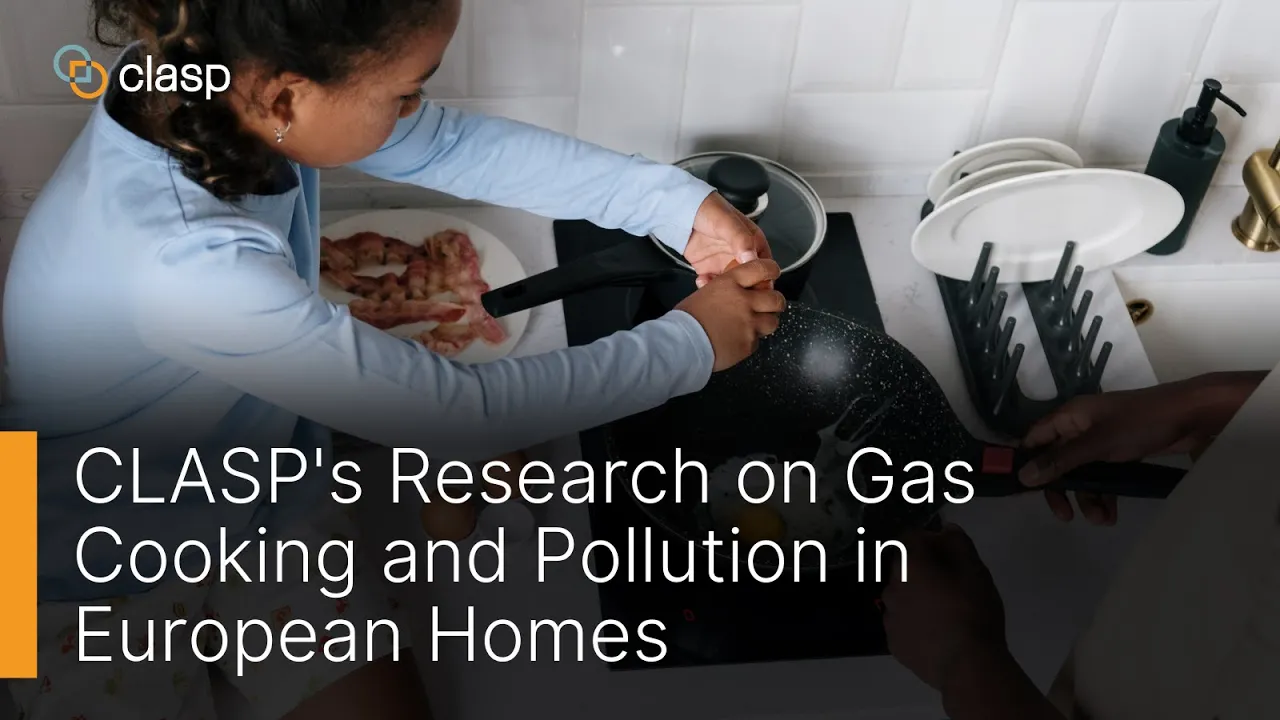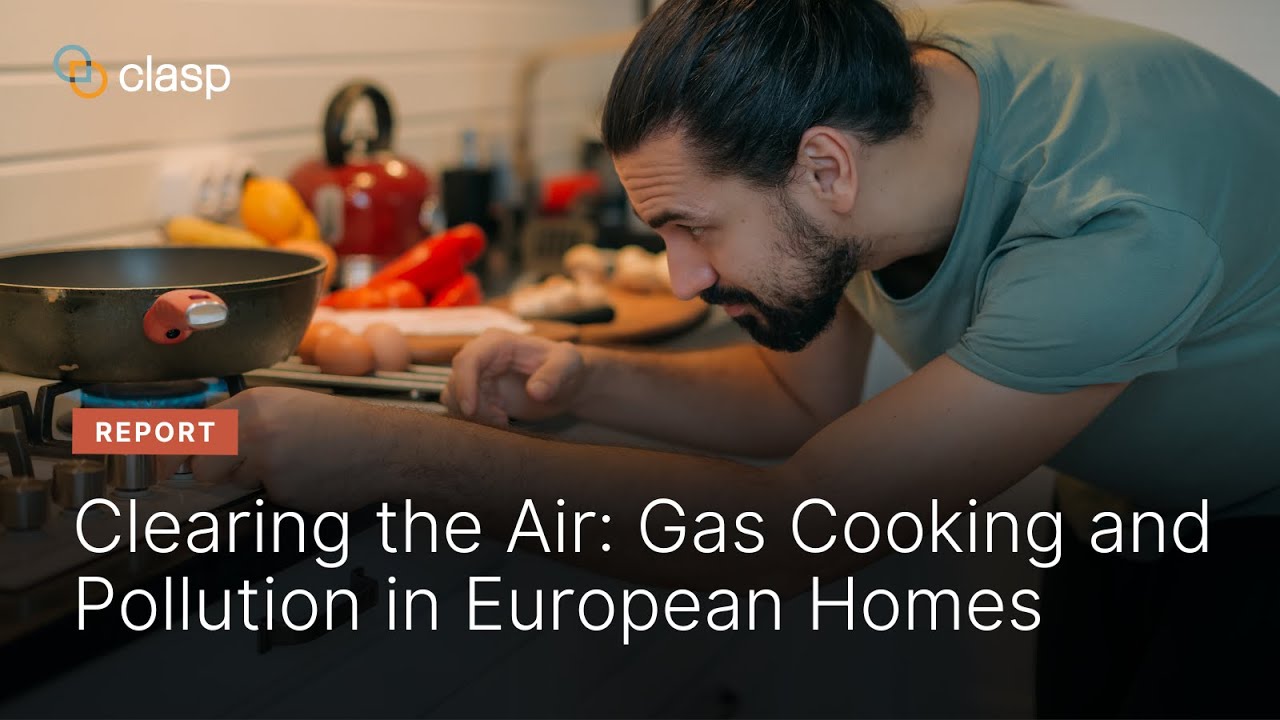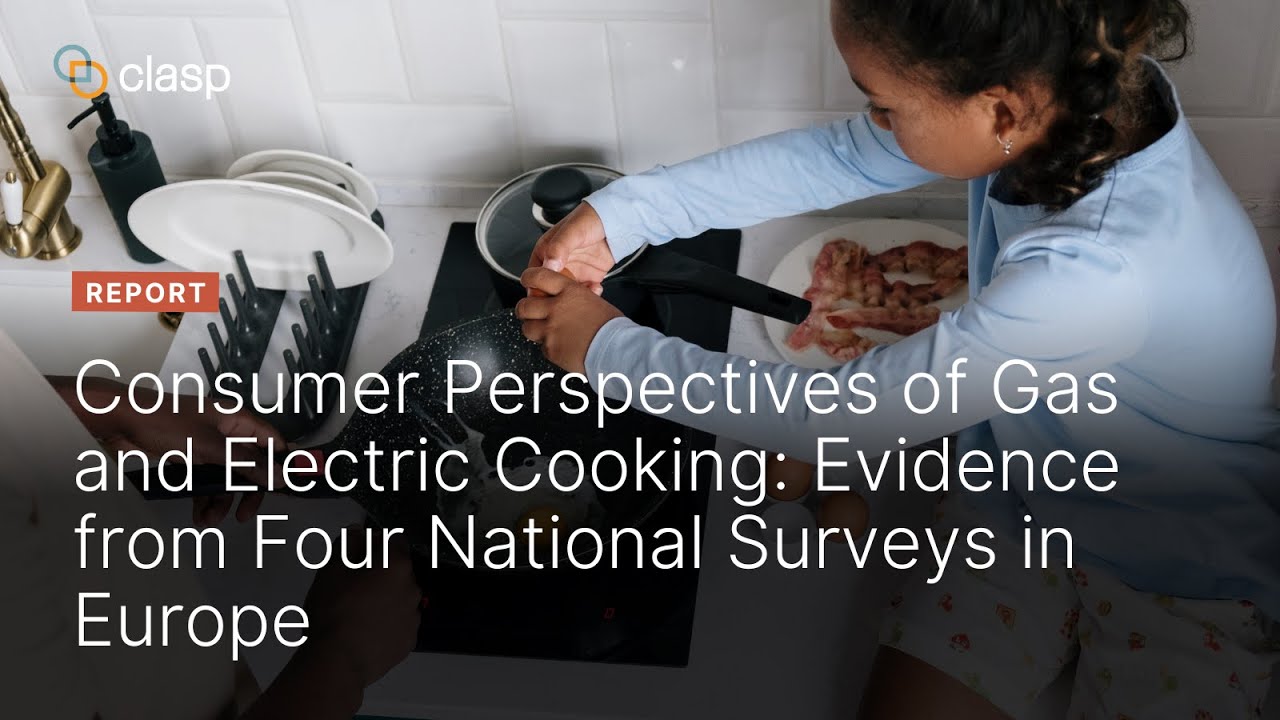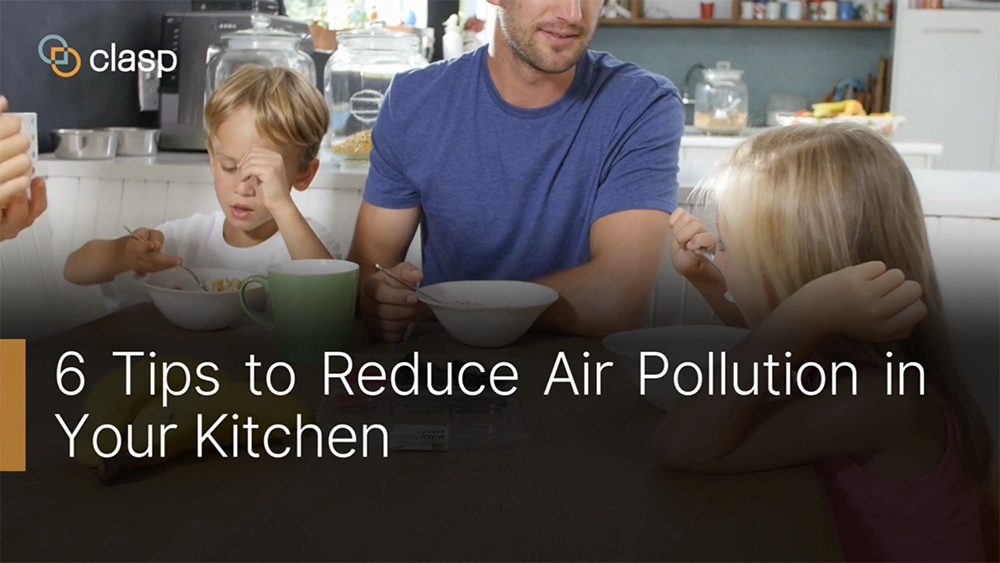National Cooking Trends from Six European Countries: Insights and Policy Recommendations
Despite advancements in electric cooking technologies, millions of households across Europe still rely on gas for cooking. Gas cooking appliances contribute to high levels of indoor air pollution and pose substantial health, environmental, and economic challenges.
CLASP’s has produced incisive factsheets on gas cooking trends in six countries. These provide insights and policy recommendations, covering consumer trends, as well as health, environmental, and cost concerns in these countries:
The Risks and the Solutions
CLASP’s research reveals elevated levels of NO2 in homes using gas stoves and ovens compared to those using electric alternatives. These levels exceed benchmarks set by World Health Organization guidelines and European Union (EU) and United Kingdom (UK) limits for outdoor air pollution.
- Health Impacts: Exposure to high levels of pollution is known to cause strokes, heart disease, lung cancer, and both chronic and acute respiratory diseases, including asthma.
- Climate Change: Gas cooking contradicts net-zero and emissions reduction targets, highlighting the need to transition to electric alternatives. The reliance on fossil fuels for domestic cooking contributes to indoor air pollution and greenhouse gas emissions, undermining efforts to mitigate the impacts of climate change.
- Consumer Trends: Despite health and environmental concerns, many consumers remain unaware of the risks of gas cooking.
- Cost Considerations: Gas cooking masks significant societal costs. While gas appliances may offer initial cost savings in some cases, the hidden costs associated with indoor air pollution, such as healthcare expenses and environmental impacts, outweigh any apparent economic benefits.
- Policy Recommendations and Regulatory Measures: In the EU and the UK, Ecodesign and Energy Labelling policies provide opportunities to advance energy-efficient and healthier electric alternatives. At the national level, governments can accelerate the transition to electric cooking through electricity tariff reforms, targeted subsidies, awareness campaigns, and holistic support. Incentives and financial assistance programs can encourage households to adopt electric cooking technologies, facilitating a shift towards cleaner and more sustainable cooking practices.
For more information on the topic, visit https://www.clasp.ngo/cook-cleaner-europe/.
Total Cost of Ownership of Domestic Gas and Electric Hobs in Europe
The use of fossil gas in cooking must be phased out to meet net zero targets in the European Union (EU) and the United Kingdom (UK). Research shows that gas hobs emit harmful pollutants and are less efficient than electric hobs, although public awareness of these issues is low.
Upcoming policy revisions by the European Commission and the UK government offer an opportunity to address these challenges. However, the research available to policymakers does not consider differences in emissions and efficiency between appliance types, potentially leading to a lack of understanding of the costs and benefits associated with transitioning to electric hobs.
To address this knowledge gap, this report provides an overview of the total cost of ownership for gas and electric hobs in the EU and UK. The analysis assumes that these appliances are purchased and installed in 2026.
Findings include:
- Contrary to the perception of gas hobs being cheaper, electric hobs are more cost-effective in a few European countries, particularly in the Netherlands, Portugal, and Sweden.
- All three electric hob technologies (hotplates, induction, and infrared) offer lower total costs of ownership than gas hobs, on average.
- The average purchase price of induction hobs is remains higher compared to other technologies, but moderate government incentives can make induction hobs affordable to more households.
- In the UK, hotplates are the most affordable option. However, the total ownership costs of all three electric hob technologies are quite similar and significantly lower than gas hobs.
- Price fluctuations may impact the total cost of ownership over time.
Beyond the Flames: Expert Insights on Gas Cooking
Have you ever wondered about the health and environmental impacts of cooking with gas? CLASP asked Professor Frank Kelly from Imperial College London, Dr. Laura Reali, a pediatrician at the Italian Public Health System, and Tony Renucci, managing director at Respire, to shed some light on the topic.
- What happens to the air in our homes when we use gas cooking appliances?
CLASP research confirms that gas stoves and ovens emit harmful pollutants such as nitrogen dioxide (NO2) directly into people’s homes. These substances can have detrimental effects on our respiratory systems and overall health.
- What are the health risks linked to cooking with gas?
Gas-cooking households experience elevated levels of NO2, an air pollutant linked to respiratory diseases like asthma. Research by the World Health Organization (WHO) on NO2 found: “The main health outcomes of interest are respiratory symptoms, bronchoconstriction, increased bronchial reactivity, airway inflammation and decrease in immune defence leading to increased susceptibility to respiratory infection.”
However, the health risks associated with gas cooking extend beyond respiratory issues. Studies suggest that exposure to gas emissions can impact everything from our lungs to our brains, affecting individuals across all stages of life. Find out more about the health risks in this CLASP report.
- Are some people more sensitive to the health impacts linked to cooking with gas?
Due to their developing lungs, children have a heightened sensitivity to pollutants. People with pre-existing health conditions, and the elderly are also more vulnerable to the health impacts of gas cooking. The WHO found that children living in homes with gas cooking appliances have a 20% increased risk of respiratory illnesses. It’s crucial to understand and address these vulnerabilities to protect those most sensitive to the risks of cooking with gas.
- Are people aware of the impacts of cooking with gas?
Many people are unaware of the elevated levels of indoor air pollution created by gas cooking. As a result, there is a lack of awareness among the general population on the health risks linked to the use of gas cooking appliances.
According to consumer surveys conducted in 2023 by CLASP and Opinium Research, in France, 53% of surveyed adults believe that the use of gas cooking appliances isn’t linked to any health issues, whereas only 34% of adults in the United Kingdom have concerns over cooking with gas appliances in their homes. CLASP found that between 58 and 74% of consumers in Europe would consider getting rid of their gas cooker if they knew it was linked with health issues.
- What can people do to protect themselves from the health risks linked to cooking with gas appliances?
People can minimize their exposure to gas cooking emissions in a number of ways. From switching to electric cooking appliances, to ensuring proper ventilation, simple actions can help reduce the health risks associated with gas cooking. Find out how to improve air quality in your home when you have a gas hob or oven here.
- Why is now the right time to switch to electric cooking alternatives?
Given the mounting evidence that links emissions from gas cooking appliances with health risks, now is the time for governments and policymakers to incentivize the transition to safer, efficient electric alternatives. CLASP research reveals that in the European Union (EU) and the United Kingdom (UK), over 180 million people are at risk of exposure to levels of indoor air pollution that exceed the EU and WHO recommended levels for outdoor air pollution. In addition, approximately €3.5 billion is spent annually in the EU and £1.4 billion in the UK in health-related costs linked to indoor air pollution from gas cooking.
- What is the solution?
To protect public health and reduce the national health costs related to cooking with gas, governments should accelerate and incentivize the transition to electric alternatives. Policymakers can tackle indoor air pollution at the source through Ecodesign standards and energy labeling policies, and define appropriate limits for indoor pollutant levels.
With energy-efficient electric options widely available in the market, it’s time to reconsider our reliance on gas appliances and embrace a cleaner, healthier way forward to protect both people and the planet.
For more information on the topic, visit https://www.clasp.ngo/cook-cleaner-europe.
Consumer study on the effects of the presence & location of the energy label in online shopping environments in Europe
The European Union’s energy label serves as a tool to inform consumer decisions on energy-efficient appliances. In collaboration with Centerdata and Ipsos, CLASP conducted a study in 2023 across four European countries — Italy, Poland, Sweden, and the United Kingdom — to explore the impact of online energy label positioning on consumer decision-making regarding household appliances.
The insights found within this report, alongside additional evidence collected from retailers, suppliers, market surveillance authorities (MSAs), and technical assessments of barriers and opportunities will inform CLASP’s regulatory recommendations and the development of harmonized guidance documents for MSAs and retailers. The evidence gathered will help improve the energy label’s impact.
This report tackles the following questions:
- How does the proximity of the energy label to the product price (low vs. high) impact consumer decision-making on different web pages?
- How does the visibility of the energy label in an online store influence consumers’ decision-making?
- How do the presence and location of the energy label on product pages affect consumers’ purchasing decisions?
- Do consumers use online shopping baskets for product comparison, and does the presence of the energy label in the shopping basket influence their choices?
- Does the energy label impact consumer decisions on price comparison websites? Do consumers actively select products that are more energy efficient?
- How does the presentation of the web store (desktop vs. mobile) influence consumer choices?
CLASP’s study revealed several key findings:
- The exact position of the energy label within web store pages did not significantly affect consumer product choices.
- Consumer engagement with energy label information, such as clicking on energy arrows or viewing product information sheets, was minimal.
- The presence of the nested energy label next to products in shopping baskets and on price comparison websites promoted energy-efficient options and helped increase energy-efficient choices.
- The effects of the presence and position of the energy label on various web pages of a web store (main page, product pages, basket page) did not significantly depend on device type (desktop vs. mobile) used to complete the experiment.
The study’s findings highlight the importance of online energy labeling in guiding consumer choices towards more energy-efficient appliances. While the exact placement of the energy label may have limited impact, its presence in strategic locations within online retail settings can significantly influence consumer decision-making.
Electrifying Cooking for Healthier and Cleaner Homes
In our daily lives, an often-overlooked activity may be impacting our health more than we realize. When we burn gas in our homes, we’re not just preparing meals; we’re cooking up a cocktail of pollutants. These pollutants pose health risks, particularly for vulnerable individuals and those with pre-existing conditions like asthma, according to environmental health expert Frank Kelly, a professor at Imperial College London. Transitioning from gas to electric hobs and ovens can eliminate the health risks associated with gas combustion, Kelly said.
The field study
In 2023, CLASP, in collaboration with TNO and Opinium, carried out the largest indoor air quality study focused on gas cooking ever conducted in Europe to understand the extent of the problem. Researchers provided air quality sensors to 250 households across 7 European countries. Over two weeks, the sensors measured and recorded levels of nitrogen dioxide (NO2), carbon dioxide, and particulate matter emitted in kitchens.
In kitchens equipped with gas stoves, researchers found that levels of NO2 often exceed the World Health Organization’s (WHO) air quality guidelines and outdoor air pollution limits in the European Union (EU) and the United Kingdom (UK). The study’s findings demonstrate the necessity to improve air quality in our homes, along with a critical need to inform people about the health risks associated with gas cooking and transition to cleaner cooking alternatives.
The hidden cost of cooking with gas
The repercussions extend beyond health; they’re also impacting our wallets. Each year, indoor air pollution related to gas cooking is estimated to cost the European Union around €3.5 billion and the UK government approximately £1.4 billion. These costs include lost earnings, decreased productivity, increased healthcare expenses, and missed educational opportunities.
A recipe for change
Professor Frank Kelly emphasizes that, given the wealth of information linking gas use to health issues and climate impact, “the use of gas is now outdated.” There is a pressing need for change. The most significant decrease in indoor concentrations of NO2 can be accomplished by making the switch from gas to electric cooking appliances. Accelerating the transition to electric cooking is identified by experts as the most effective solution, alongside raising awareness about the need for adequate ventilation.
To safeguard public health, action is required. Governments, industry leaders, healthcare providers, researchers, and individuals all have a role to play in reducing indoor air pollution related to gas cooking:
- Government: Policymakers across the EU and UK can help accelerate the transition to electric cooking by strengthening appliance standards and establishing energy labels for hobs that inform consumers about pollution levels.
- Industry: Manufacturers and retailers should privilege the production of electric cooking appliances, make the most efficient products more affordable, and discontinue the production of gas hobs and ovens.
- Civil society and healthcare: Advocates should raise awareness of the health risks associated with the use of gas cooking appliances.
- Research: By conducting further studies and fostering innovation, researchers can contribute valuable insights to guide policy decisions and technological advancements.
- On an individual level, adopting cleaner electric hobs and ovens is recommended to limit exposure to NO2. Ventilating kitchens during and after cooking is a simple, practical step toward mitigating the health risks associated with the use of gas hobs and ovens.
Our culinary choices carry significant health, economic, and environmental weight. Let’s make informed choices to protect our health and contribute to a cleaner future.
CLASP is working with governments to ensure they consider frameworks and incentives that encourage a transition away from gas cooking to electric alternatives.
For more information, visit https://www.clasp.ngo/cook-cleaner-europe/.
Gas Cooking Appliances Cause Regular Pollution Breaches in Homes across Europe
Brussels, Belgium – Cooking on gas regularly fills kitchens with air pollution above recommended levels, the largest-ever home monitoring study in Europe has found.
The World Health Organization (WHO) daily limit value for nitrogen dioxide (NO2) exposure was broken in most (57.3%) of the homes using gas hobs and/or gas ovens that were tested under normal living conditions by leading scientific researchers.
NO2 levels were found to be almost twice as high in kitchens, living rooms, and bedrooms in homes cooking on gas compared to those using electric appliances, on average. Breaches in 15.9% of homes using electric appliances were caused mainly by outside air pollution blowing in, the researchers say.
The research, commissioned by nonprofit energy efficiency group CLASP, was conducted by the Netherlands Organisation for Applied Scientific Research (TNO). Sensors were placed in 247 homes [1] in seven countries with large populations cooking on gas and childhood asthma cases linked to cooking on gas.
Breaching limit values increases health risks. NO2 can cause inflammation of human airways, coughing and wheezing, reduced lung function, and increased asthma attacks, especially in children. Children in homes with a gas cooking appliance have a 20% increased risk of suffering a lower respiratory illness, the WHO estimates.
Pollution spikes in homes cooking on gas could last several hours and were more intense the longer the cooking time, the researchers found. Added together, the WHO daily limit was breached for 3.25 days over the 13-day testing period, on average. Where kitchens had fans to extract fumes outdoors, they did not clear much pollution. This is because of improper use, the researchers think.
Extrapolating to a year, the data shows that a quarter of homes (25%) cooking on gas breached EU and UK hourly NO2 limits for outside air quality. Authorities across Europe have been forced to respond to breaches of these limits. Yet EU regulators have not set limits for indoor air pollution.
Little has been done to prevent NO2 pollution from gas cooking appliances in Europe, CLASP wrote in its report summarizing the research. Various regulations could limit air pollution from appliances, but fail to, it said. The problem could be corrected at EU level next year when new design and labelling rules are expected to be adopted.
At a stakeholder meeting with EU officials, initially set for 30 November 2023 and postponed until March 2024, CLASP will call for a new EU energy label comparing gas and electric hob efficiency and highlighting pollution levels.
Nearly a third (32.5%) of homes in the EU cook on gas. But few are aware of the risks due to the invisible nature of the pollution, according to a recent opinion poll commissioned by CLASP and conducted by Opinium. If made aware, up to three quarters of respondents (74%) say they would consider getting rid of their gas appliances.
Nicole Kearney, CLASP Europe Director, said: “Our research reveals the severity of air pollution caused by gas cooking appliances in homes across Europe. Cooking up a change starts with awareness. Empowering people with knowledge on the health risks of these products is essential, and they need resources to upgrade to cleaner and healthier hobs and ovens. In turn, governments must protect public health, tackling air pollution at the source and supporting the transition to cleaner cooking.”
TNO senior scientist, Piet Jacobs, said: “Based on our field study data we estimate that in about 25% of the European kitchens cooking on gas the EU NO2 limit value for 1-hour exposure is exceeded, where outside levels were below these values. Changing to electric cooking, preferably combined with use of well-designed ventilation hoods to reduce exposure to high levels of particulate matter from cooking, can bring these values down to below recommended levels.”
Professor Frank Kelly of Imperial College London said: “Gas hobs and ovens are a major source of indoor air pollution, including NO2, which can both exacerbate existing health conditions and potentially lead to new respiratory illnesses. For children with asthma, the presence of gas cooking appliances can intensify their symptoms. Removing these appliances from our homes will improve indoor air quality and mitigate potential risks to public health.”
The scientists also measured for fine particulate matter. In kitchens, this is caused by outdoor pollution blowing in and food cooking, rather than the appliance fuel source. The scientists found no significant difference in emissions between homes cooking on gas and electric.
Ends
CLASP Report – Clearing the Air: Gas Cooking and Pollution in European Homes
TNO Report – Health Effects in Europe from Cooking on Gas – Phase II Field Study
Press releases are available in the following languages:
Dutch, English (UK), English (US), French, German, Hungarian, Italian, Romanian, Slovak, Spanish.
Contacts
- CLASP Europe director Nicole Kearney (EN) +44 75 4486 5924
- CLASP Europe senior communications associate Païline Caroni (EN, FR) +32 473 127 674.
- ICL professor Frank Kelly (EN) +44 (0)20 7594 8098
- CLASP communications consultant Jack Hunter (EN) +33 751 051 805
- TNO press officer Maarten Lörtzer (EN, NL) +31 620420732.
About CLASP:
CLASP is an international nonprofit leading the research and promotion of appliance efficiency and energy access to improve the lives of people and the planet. CLASP works to combat climate change and drive the transition to a more energy-efficient and just future where no one is left behind. Headquartered in Washington DC, and based in Beijing, Brussels, Dehli, Jakarta and Nairobi, CLASP works with governments, appliance manufacturers and partners to advance positive change on a global scale.
Notes
[1] Market research firm Opinium selected 40 homes each in France, Italy, the Netherlands, Romania, Slovakia, Spain, and the UK, where residents cook at least 3 days a week, are non-smokers, and are not near busy main roads or industrial plants. More than 40% of homes include children. One in 5 cook purely on electric, while 4 in 5 cook purely on gas, either ovens, hobs or both. In all homes, sensors were placed in the kitchen, living room and a bedroom to measure NO2, fine particulate matter, and carbon monoxide. Outdoor sensors detected NO2. Participants were told to cook and behave normally. Each was paid €100. Only data from 247 homes that successfully followed instructions over a 13-day period in 2023 were included. The previous largest EU study of exposure to NO2 based on continuous sensor data took readings from 16 homes.
Clearing the Air: Gas Cooking and Pollution in European Homes

Our research reveals the severity of air pollution caused by gas cooking appliances in homes across Europe. Empowering people with knowledge on the health risks of these products is essential, and they need resources to upgrade to cleaner and healthier hobs and ovens. In turn, governments must protect public health, tackling air pollution at the source and supporting the transition to cleaner cooking.Nicole Kearney
CLASP Europe Director
In collaboration with the Netherlands Organisation for Applied Scientific Research (TNO) and Opinium Research, CLASP conducted a study across seven European countries in 2023 to assess the impact of gas cooking on indoor air quality. The research involved monitoring in-home air quality in gas- and electric-cooking households, collecting household and cooking behaviour data, and analysing indoor pollutant concentration levels.
The report tackles several critical questions:
- What are the levels of indoor air pollution in households with gas cooking appliances and how do they compare to households that cook with electric appliances?
- How do these pollution levels compare to established mandatory outdoor air quality standards as well as pollution levels recommended by the WHO?
- Is ventilation enough to mitigate the health risks linked with gas cooking, or is a transition to cleaner cooking technologies necessary?
The report’s key findings provide a compelling call to action:
- Gas cooking often results in indoor air pollution that exceeds WHO air quality limits, putting citizens at risk of severe health issues.
- Many households with gas cooking appliances exceed WHO air quality guidelines for nitrogen dioxide (NO2).
- Electric-cooking households, in contrast, enjoy significantly better indoor air quality, free from NO2 pollution caused by kitchen appliances.
- Ventilation alone is insufficient to mitigate the pollution, necessitating a transition to cleaner electric cooking.
To safeguard public health, it’s essential to educate people about the health risks associated with gas appliances and provide them with resources to transition to cleaner and healthier cooking technologies. CLASP calls for collaborative efforts from governments, industry, civil society, healthcare providers, and individuals to improve indoor air quality across Europe.
Additional Resources
TNO Report: Health Effects in Europe from Cooking on Gas – Phase II Field Study
Executive Summary Translations
Dutch, French, German, Hungarian, Italian, Romanian, Slovak, Spanish
Press Releases
Dutch, English, French, German, Hungarian, Italian, Romanian, Slovak, Spanish.
Report Figures Available for Download
Figure 1. Gas cooking appliances directly emit harmful pollutants, whereas PM2.5 is emitted by the process of cooking food
Figure 2. Criteria for household monitoring selection
Figure 5. Comparison of average NO2 concentrations in gas- and electric-cooking homes
Figure 6. Average NO2 concentrations per country and per cooking method in different rooms
Figure 9. Average exceedance of WHO and EU/UK NO2 limit values in gas- and electric-cooking homes
Figure 10. Average number of exceedance days of the WHO daily guideline value during the 13-day measurement period
Figure 11. Highest hourly CO concentrations found in the kitchen, per country and per cooking method
Figure 12. Average PM2.5 concentrations in the kitchen, per country and per cooking technology
Figure 14. Overview of ventilation types recorded in the study
Figure 15. Comparison of average indoor-attributed NO2 concentration throughout the home, by cooker type
Figure 16. Average PM2.5 concentration in kitchen for all homes cooking on gas and electric hobs
Figure 17. Reasons for using ventilation in the kitchen: results from a 2023 CLASP consumer survey
Figure 18. Average NO2 concentrations in the Netherlands in the kitchen, living room, bedroom, and outdoors
Figure 19. Map of gas- and electric-cooking households in the Netherlands showing NO2 levels
Figure 21. Average NO2 concentrations in Italy in the kitchen, living room, bedroom, and outdoors
Figure 22. Map of gas- and electric-cooking households in Italy, based on severity of NO2 levels
Figure 24. Average NO2 concentrations in Spain in the kitchen, living room, bedroom, and outdoors
Figure 25. Map of gas- and electric-cooking households in Spain, based on NO2 levels
Figure 27. Average NO2 concentrations in France in the kitchen, living room, bedroom, and outdoors
Figure 28. Map of gas- and electric-cooking households in France, based on severity of NO2 levels
Figure 30. Average NO2 concentrations in Slovakia in the kitchen, living room, bedroom, and outdoors
Figure 31. Map of gas- and electric-cooking households in Slovakia, based on severity of NO2 levels
Figure 33. Average NO2 concentrations in Romania in the kitchen, living room, bedroom, and outdoors
Figure 34. Average corrected NO2 concentrations in Romania, taking into account higher levels of outdoor air pollution
Figure 35. Map of gas- and electric-cooking households in Romania, based on severity of NO2 levels
Figure 37. Average NO2 concentrations in the United Kingdom in the kitchen, living room, bedroom, and outdoors
Figure 38. Map of gas- and electric-cooking households in the United Kingdom, based on severity of NO2 levels
Guidance Materials for Participating Households
Field Testing Equipment Overview
Field Testing Equipment Installation Guide
Household Recruitment Questionnaire
Instructional Videos for Participating Households: Dutch, English, Italian, French, Romanian, Slovak, Spanish
Visit our Cook Cleaner Europe page to view additional resources on gas and electric cooking.
Consumer Surveys Reveal Insights on European Perspectives of Gas and Electric Cooking
Key findings from the report include:
- A willingness to switch to electric for health reasons: The majority of respondents (ranging from 58% to 74% in different countries) would consider abandoning their gas cookers if they were aware of health issues associated with them. This highlights a significant opportunity to reduce indoor air pollution and protect public health through further awareness-raising activities.
- Safety perceptions: Consumers generally perceive electric cooking as safer than gas despite lacking full awareness of the health risks associated with gas appliances.
- Barriers to switching: Consumers view cost as a significant obstacle to transitioning from gas to electric cooking. Renters face additional challenges, with many reporting an inability to change to electric appliances.
- Public support for government intervention: An overwhelming majority of respondents (ranging from 77% to 88% in different countries) strongly supports government initiatives aimed at promoting electric cooking.
- Energy efficiency concerns: Consumers care about the energy efficiency of their cooking appliances but lack the tools to effectively compare gas and electric options. They strongly support the idea of an energy-efficiency label for hobs and ovens.
Further research and action are needed to overcome the barriers to electrifying cooking in Europe. Facilitating the transition to electric cooking, raising awareness of health risks, and implementing energy-efficiency labels can pave the way for healthier and more sustainable households.
Additional resources on gas and electric cooking in Europe
For media inquiries and more information, please contact
Païline Caroni
Senior Communications Associate (Europe) – CLASP
pcaroni@clasp.ngo
About CLASP:
CLASP is an international nonprofit leading the research and promotion of appliance efficiency and energy access to improve the lives of people and the planet. CLASP works with governments, industry, communities, and others to propel policies and markets toward the highest-quality, lowest resource-intensive products possible.
Consumer Perspectives of Gas and Electric Cooking: Evidence from Four National Surveys in Europe

Our latest surveys demonstrate that a substantial number of households in Europe would be ready to switch from gas to electric appliances if they knew about the health issues linked with gas cooking. CLASP’s research highlights the importance of raising awareness on the health impacts of cooking with gas and establishing an energy label for both gas and electric cooking appliances. By facilitating the transition to electric cooking, we can pave the way for healthier, safer, and more sustainable households.Nicole Kearney
CLASP Europe Director
While decades of scientific research have established a correlation between the emissions from gas cooking appliances and detrimental health impacts, the findings have not been widely circulated amongst the European public. As a result, misconceptions and misinformation about the safety, performance, and efficiency of electric alternatives remain widespread.
This report’s findings are drawn from surveys conducted among nationally representative samples of 3,000 adults in France, Romania, Spain, and 2,000 adults in the United Kingdom (UK). It offers European policymakers valuable insights into consumer perspectives on both gas and electric cooking appliances.
CLASP’s research questions address the following:
- Consumer use of and reasons for gas versus electric cooking appliances.
- Awareness of the health risks associated with gas cooking, and practices – such as ventilation – that can reduce risks.
- The importance of energy efficiency in major appliance purchase decisions and the value of a comparative energy label for gas and electric cookers.
- The level of support for government schemes to accelerate the transition to electric cooking.
Key findings of the report include:
- Variations in preference and usage of gas and electric cooking appliances are evident across countries, but also among distinct demographic segments.
- Cost emerges as a significant barrier for consumers, hindering the transition from gas to electric appliances. Renters wanting to switch to electric cooking appliances may face obstacles, despite their preference for such appliances.
- Consumers perceive electric cooking as safer than gas cooking, yet many remain unaware of, or indifferent to, the health risks associated with gas cooking appliances.
- Most respondents (58–74%) said they would consider getting rid of their gas cooker if they knew it was linked with health issues.
- Less than 20% of respondents across all countries indicated using ventilation to mitigate indoor air pollution when cooking.
- There is substantial public support for government initiatives aimed at promoting electric cooking in Europe.
- Consumers express a strong interest in the energy efficiency of their cooking appliances; however, they lack the means to effectively compare different types of hobs. Consumers strongly support the implementation of an energy efficiency label for both hobs and ovens.
While this report provides valuable insights, further research is needed to understand the barriers and opportunities for electrifying cooking across Europe.
Translations of the report’s executive summary are available:
- French: Résumé – Les perspectives des consommateurs européens sur la cuisson au gaz et à l’électricité : Preuves tirées de quatre enquêtes nationales
- Italian: Riepilogo – I punti di vista dei consumatori europei sulla cottura a gas ed elettrica – i risultati di quattro indagini nazionali
- Romanian: Rezumat – Perspective ale consumatorilor europeni în privința gătitului cu gaz și electric: Dovezi din patru sondaje naționale
- Spanish: Resumen – Perspectivas de los consumidores europeos sobre las cocinas eléctricas y de gas: Cuatro encuestas nacionales
Individual survey reports:
Visit our Cook Cleaner Europe page to view additional resources on gas and electric cooking.
International Clean Air Day: 6 Tips to Reduce Air Pollution in Your Kitchen
Did you know indoor air pollution levels can often be higher than the outdoors? Kitchens contain sources of air pollution that impact our health and the environment. To mark this International Day of Clean Air for blue skies, here are some tips that will help you reduce air pollution and breathe new life into your cooking haven.
1. Embrace electrification
Electrification is a game-changer when it comes to reducing levels of indoor air pollutants.
- Use electric or induction cooktops instead of gas burners to reduce indoor air pollution.
- Choose electric appliances instead of gas hobs and ovens, such as microwaves, kettles, air fryers and toasters, whenever possible.
2. Vigorously ventilate
Effective ventilation is essential to reduce indoor air pollution.
- If you can, open the windows when cooking.
- Turn on your ventilation hood, if you have one, when preparing meals, and keep it running for several minutes after cooking.
3. Cook cleverly
Minimise cooking emissions through healthy cooking practices.
- Avoid overheating oils and fats, which can release harmful fumes. Choose oils with higher smoke points.
- Opt for cooking methods that produce fewer emissions, such as baking, steaming or microwaving. These methods generate less fumes compared to deep-frying or grilling, for example.
4. Master maintenance
Regularly clean and maintain kitchen appliances to prevent the build-up of pollutants and cooking residue that can emit harmful particles when heated.
- Clean kitchen surfaces and appliances with eco-friendly, non-toxic cleaners. Opt for products that do not contain irritants, flammable components and fragrances.
- Fix leaky faucets and pipes to prevent moisture-related air pollution.
- Keep your kitchen well-ventilated during and after cleaning and open any doors and windows.
5. Purify perfectly
If you are looking to improve indoor air quality, there are options to explore.
- Air purifiers can help reduce fine particles and pollutants produced during cooking.
6. Monitor air quality
Indoor air quality is closely linked to outdoor conditions, so keep an eye on the air quality in your area. Different technologies can help you monitor the air quality of your kitchen:
- Smoke detectors are becoming more sophisticated and detect not only smoke, but can also detect specific pollutants, such as carbon monoxide (CO), carbon dioxide (CO2), nitrogen dioxide (NO2) and particulate matter (PM), to name a few.
- If you already have a smoke detector that does not monitor pollutants, think of using an indoor air quality monitor or sensor that can empower you to proactively address air quality concerns.
If you or someone in your household is experiencing health symptoms that might be linked to indoor air pollutants, it is important to consult a healthcare professional.




